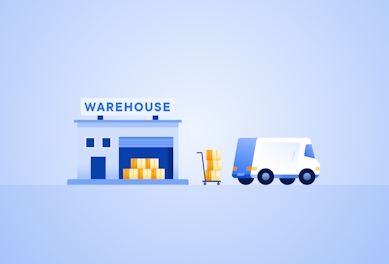How to Calculate Inventory Shrinkage
Inventory shrinkage is when the amount of inventory your business has differs from the amount of inventory on record. Find out how to calculate it.

Use Circuit for Teams to plan and track deliveries, simplify business shipping, and help prevent product loss.
Inventory shrinkage is easy to calculate: Subtract the total value of the inventory you actually have from the total value of the inventory you’re supposed to have.
No complicated equations or algorithms needed (yay!).
The number you get from that simple subtraction is the value of your inventory shrinkage — when the amount of inventory calculated in your accounting records doesn’t match how much you actually have on hand.
Why does inventory shrinkage matter (hey, if you’re going to do math, it better be worth it, right)?
Inventory is a business asset.
Whether you’re selling knitted hats, fresh produce, or computer parts, your inventory — the physical products you sell to customers — has value.
Inventory shrinkage can happen for various reasons, from vendor fraud to employee theft or clerical errors (like miscounting inventory).
Whatever the cause, shrinkage causes you to lose money.
Why?
You’ve invested money in getting or creating your inventory — and that money is wasted if you can’t sell inventory to customers for a profit.
According to Forbes, inventory shrinkage costs the US retail industry some $46.8 billion per year.
Clearly, you don’t want your own inventory discrepancies to contribute to this number.
I’ll talk about what inventory shrinkage is and how to calculate it.
I’ll also describe common causes of shrinkage and give you some tips for inventory loss prevention.

What is inventory shrinkage?
Inventory shrinkage happens when your business’s actual inventory levels are less than your recorded inventory levels.
Let’s say your accounting department claims you have 1,000 pieces of inventory. But, upon counting your inventory, you find you only have 995 pieces. That’s inventory shrinkage.
Inventory shrinkage can happen because of a paperwork error.
For example, the accounting department can make a mistake during inventory control (the process of managing inventory levels by counting pieces of inventory to learn when it’s time to order more).
They recorded 1,000 pieces, but there were actually only 995 pieces. Bingo.
Inventory shrinkage can also happen because of operational reasons, like inventory damage or loss.
Inventory shrinkage formula
Figuring out your inventory shrinkage value involves a little math — but it’s not too complicated.
Here’s the formula:
Total Value of Inventory Recorded by Accounting - Total Value of Inventory You Actually Have = Inventory Shrinkage Value
It’s also possible to turn this number into a percentage — this is called your inventory shrinkage rate.
This can be useful since it’s easier to compare percentage values than total values.
To do this, divide your inventory shrinkage value by the actual inventory number.
Then, multiply that by 100 to get a percentage.
Here’s the formula for inventory shrinkage percentage:
Inventory Shrinkage Value / Total Value of Inventory Recorded by Accounting = Inventory Shrinkage Rate x 100 = Inventory Shrinkage Rate Percentage
Inventory shrinkage example
An example of inventory shrinkage in action can help show how inventory shrinkage hurts your bottom line.
Let’s say you sell knitted hats through an eCommerce platform.
Each hat takes two hours to make.
You pay your employees $15 per hour, so that’s $30 in wages per hat.
Plus, each hat requires $20 worth of material.
In total, a single hat costs $50 to make.
Your warehouse holds 100 hats.
That’s technically $5,000 worth of inventory ($50 per hat times 100).
But let’s say you have a moth infestation in your warehouse.
The moths destroy ten hats. You can’t sell those hats to customers.
Your inventory accounts department has a record of 100 hats in storage.
But now you only have 90 hats in storage.
So, to calculate your inventory shrinkage, use the formula:
Total Value of Inventory Recorded by Accounting - Total Value of Inventory You Actually Have = Inventory Shrinkage Value
That means:
$5,000 ($50 value per hat times 100) - $4,500 ($50 value per hat times 90)
= $500 Inventory Shrinkage Value
That’s $500 of inventory shrinkage ($500 worth of hats you can’t sell to customers).
And how does that translate to profits?
Let’s say you sell your hats at $60 each, giving you a $10 profit on each hat ($60 in sales - $50 for production = $10 in profits).
If you sold them all, a warehouse of 100 hats would give you $1,000 worth of profits ($10 per hat times 100).
In contrast, a warehouse of just 90 hats would give you just $900 worth of profits ($10 per hat times 90). Again, that’s only if you sell all of the hats.
That moth infestation cost you $100 in profits!
Remember, you can also calculate an inventory shrinkage rate percentage.
This can make it easier to compare how your inventory shrinkage changes over time (for example, by comparing your percentage rates from Q1 to Q2, Q3, and Q4).
Here’s how we’d put the formula into action in this example:
500 / 5,000 = 0.10 x 100 = 10%

Causes of inventory shrinkage
As you can see, inventory shrinkage can cost you money. You want to do all you can to prevent it (and protect your money).
Here are some possible reasons for inventory shrinkage:
- Theft: Unfortunately, theft is one cause of inventory shrinkage. Employees may steal items if they have access to them in a warehouse or storage facility, for example. Shoplifting can also result in product losses.
- Supplier fraud: Some vendors may try to cheat customers by delivering less inventory than they’ve been contracted or paid to deliver. This can be a cause if you rely on external suppliers for inventory instead of making your own.
- Breakage or spoilage: Sometimes, inventory shrinkage just comes down to freak accidents. Flooding could cause water damage to products, for example, or an employee might drop a pallet of goods and damage them.
- Human error: Aside from breakage, humans can cause inventory shrinkage, like clerical errors. For example, someone in the accounting department could make a mistake when counting inventory.

How to prevent inventory shrinkage
Now that you know some of the common causes of inventory shrinkage, you’re probably wondering how to prevent it.
Here’s a quick rundown of some ways to reduce the risk of inventory shrinkage:
- Track your inventory. Tracking inventory using digital barcodes that you scan at every step of the supply chain can help decrease employee theft. For example, a delivery driver might be less likely to steal a product if they have to scan it and be held accountable by name. Inventory tracking is just one way to improve material handling — the way products and materials are moved, stored, and protected throughout the supply chain.
- Do physical inventory counts regularly. There are a few points when inventory should be counted, for example, after delivery by a vendor. This can help reduce the risk of supplier fraud. Double-check your inventory counts regularly. You might have a daily or weekly schedule, for example. Also, make sure to change out inventory duties. Don’t make just one person responsible for tracking inventory. This can lead to errors (or theft).
- Boost your security. Trackable barcodes are one way to improve security. You can also improve warehouse management with security measures like keeping expensive inventory locked up (for instance, so it’s only accessible with an employee code). If you run a physical store, security systems like shoplifting alarms and CCTV cameras can help fight shoplifting.
- Protect your products. Safeguard against potential product damage by storing inventory in a safe, dry space. For example, make sure shelving units are secure so inventory can’t slip off. You also want to protect your products after they’ve left your warehouse. Choosing the right packaging for shipping products can help goods reach customers safely.
- Invest in inventory management tools. You can use an inventory management system to track your inventory levels with every inventory cycle count. Inventory cycle counting is the process of physically counting inventory (daily or monthly, for instance) to make sure actual inventory levels match recorded inventory levels. This can also improve your capacity planning — the processes and tools you use to keep up with supply chain demand. For example, you can use inventory management software for automating reorders when you’re running low on inventory.
- Work with a third party. If keeping up with inventory is too much of a hassle, you can outsource the job to a third-party fulfillment company. Professionals can handle details like storing, counting, and tracking inventory. They’ll even fulfill orders — picking, packing, and shipping inventory for you. These companies usually use software to track inventory and can offer detailed reports on inventory levels, making it easy to identify and address shrinkage.
Keep track of your inventory at all stages of the supply chain
Inventory shrinkage happens when the amount of inventory you actually have doesn’t match the amount of inventory recorded in your accounting books.
It’s important to track your inventory shrinkage since the loss of inventory can cost your business money — and, ultimately, hurt your bottom line.
Regularly calculating inventory shrinkage can help you recognize it quickly when it happens and investigate the possible causes.
There are many possible reasons for shrinkage, from damage to shoplifting and administrative errors.
Once you have a better idea of the reasons for inventory shrinkage, you can help combat it with increased warehouse security and inventory tracking.
You also want to protect your inventory during last-mile delivery (the final step in order fulfillment, when inventory goes from a warehouse or shipping center to the customer).
Practical steps, like using protective packaging and knowing which shipping labels and forms to use, can help packages reach customers safely.
If you have a shipping or retail business and manage your own last-mile delivery, a tool like Circuit for Teams can also help.
Circuit for Teams allows you to track deliveries in real time, so you always know where inventory is once it’s out for delivery.
Circuit for Teams can also help your business save money in other ways.
The route optimization tool finds the fastest sequence of delivery stops for delivery drivers, so you can save money on transportation costs like gas, for example.
Plus, Circuit for Teams has a proof-of-delivery feature and the ability to set delivery time windows.
You can even send customers real-time updates about their deliveries.





